The Sir Ross Smith Memorial commemorates the achievements of aviator Sir Ross Smith and the first flight from England to Australia. The monument was unveiled at Creswell Gardens on 10 December 1927 by Lieutenant-Governor Sir George Murray. The statue itself is made from bronze sculptured in the image of Sir Ross Smith dressed in his flying gear. He stands high up on an obelisk with a globe of the world underneath his feet. One foot rests in Europe and the other in Australia to symbolise his famous flight. Below he is accompanied by two female bronze angels, one holding an aeroplane to represent flight and the other wearing a winged helmet to represent fearlessness. The obelisk is decorated with bronze plates depicting the events that took place during the voyage from England to Australia.
Ross Smith, The Aviator
The arrival of Ross Smith, his brother Keith Smith and mechanics James Bennett and Wally Shiers in Darwin, Australia on the 10 December 1919 was greeted with ecstatic admiration. The early twentieth century was a period of great interest in the developing technology of aviation and consequently, the high esteem for Australian pilots had escalated dramatically. The famous ‘air race challenge’ was a competition for Australian aviators to fly from London to Australia in thirty days or less. Upon completing the challenge in twenty-eight days, Ross and Keith were knighted within two weeks of their arrival in Australia with their deeds recognised internationally. The Australian Government awarded the four men with £10 000 as their prize. It was an incredible achievement which demonstrated the fearlessness and navigation skills of the pilots. Only one other contestant of the challenge reached Australia with the race proving fatal to two crews.
Ross Smith was an inspiration to young Australians of the period. He received his education at Queen’s College in North Adelaide and was an excellent horse rider, a skill he learned on Mutooroo Station, near Cockburn, South Australia, where his father worked. His sense of leadership and military prowess made him a perfect candidate to represent Australia at Gallipoli. He was transferred from the1st Light Horse Brigade 1st Machine Gun Squadron to No 1 Squadron Australian Flying Corps on 24 Oct 1916. By 1917 he was serving as a pilot. A Vickers-Vimy aircraft which was too late to see service in the Great War was used in the race, equipped with extra fuel tankage.
Preparation of the Memorial
Ross Smith and Jim Bennet were tragically killed during a test flight in England on 13 April 1922 in preparation for a round-the-world trip. Keith Smith fortunately had missed the test flight.
A verdict of misadventure was returned (Daily Herald, 17 April 1922).
Back in Adelaide a ‘shilling fund’ was established with a committee to raise money for a memorial. The funds grew rapidly with £1500 collected within weeks.
The suggestion to erect a column or some such outstanding monument at Mount Lofty Summit as a memorial to our beloved gallant airman must commend itself to all (The Register, 8 September 1922).
There was extensive debate over the memorial’s location, suggestions included a tower at Mount Lofty which was to double as a navigation beacon for interstate flights. However it was decided that a fitting site for the Ross Smith memorial would be at Creswell Gardens, a site at which Smith himself had advocated the construction of a monument for the Third Light Horse Brigade. By the end of 1923, enough funds had been collected and the memorial committee opened a competition to sculptors from England and Australia to design the statue. The prize was won by Frederick Brook Hitch in his attempts to capture Ross Smith’s passion for flying in his work.
The Unveiling of the Memorial
The unveiling of the memorial occurred on 10 December 1927. The event was well attended as everyone paid tribute to the respected hero who had come to symbolise Australian fervour for the ever-growing development of anything aeronautical. The unveiling was accompanied by three aeroplanes circling overhead.
The hum of the engines while the speeches were being delivered sounded like a requiem in a kind of music with which the fallen hero had been so familiar (Border Watch, 13 December 1927).
A speech was given by the Governor Sir George Murray who claimed the memorial was ‘a fitting tribute to South Australia’s most famous son’. The ninetieth anniversary of the arrival of Sir Keith and Sir Ross Smith into Darwin in 1919 was commemorated with a service at the statue in Creswell Gardens on 13 December 2009 at 11am. The commemoration also observed the ninetieth anniversary of the England to Australia Air Race which commenced in the same year, 1919. The ceremony was organised by The Return and Service League and the Queens Old College Boys Association (where the Smith brothers attended college in 1902).


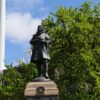

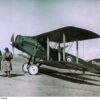

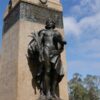
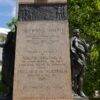
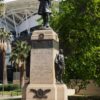
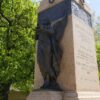


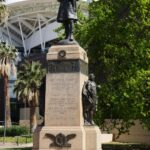
Comments
4 responses to “Sir Ross Smith Memorial”
Last weekend,I was at Centennial Park saying hello to my Mom and Dad
and I thought that I would look for Wally Shiers grave ,which I found after some looking.
I was disappointed that a person that has a place in Australian history is laid to rest in such a nondescript way. Question is ,do you know if any thing will be done to highlight his site as dec .1919 approaches?
Hi Gary, there are definitely plans progressing to mark the anniversary of the flight, but whether anything specifically highlighting Wally’s burial site is in the mix I’m not sure. I’ll keep you posted as we find out more about what’s happening.
Thanks Catherine for your reply, I’ll keep watching for any progress!
Gary
Hi Gary,
I’m told there will be something at Centennial Park in May as part of the History Festival program. Full details will be released when that program is live, which will be 6 April: https://historyfestival.sa.gov.au/